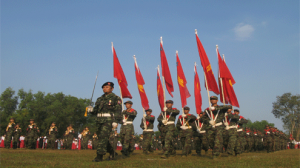By LAWI WENG & AKAR-The Burmese junta described the New Mon State Party (NMSP), a former cease-fire group, as “insurgents” in state-run-newspapers on Friday, no longer referring to the ceasefire status that NMSP maintained from 1995 until April 2010.

The New Light of Myanmar, a Burmese state-run newspaper, described the NMSP as “insurgents” in a report on fighting that occurred between the Mon National Liberation Army (MNLA), the armed wing of NMSP, and a splinter group from the NMSP, called the Mon Defense Army. Fighting occurred on January 31st, and one innocent civilian died during the conflict in Kyaikmayaw Township, Mon State.
The Mon Defense Army formed in 2009. It is a small force of only 10 troops led by Nai Than Lwin, a former member of the NMSP.
The report has come after the collapse of the ceasefire agreement between the Burmese regime and the NMSP when the NMSP refused to become part of the Border Guard Force (BGF), in which NMSP troops would have to transform into a Burmese-army controlled military group.
U Ka Hlaing, was 83 years old, when he was shot in Mathayo village, Kyaikmayaw township, during fighting that took place for a half hour, reported the New Light of Myanmar.
Sources close to the NMSP also reported two MNLA soldiers wounded during the fighting.
Responding to Naypyidaw’s usage of “insurgents,” Nai Hongsa, NMSP secretary, said, “We have already expected that they will call us ‘insurgents’ again. We are not sad nor surprised to hear it.”
“Because we refused to join the BGF, they [the Burmese government] tried to hold back their anger in order to maintain their dignity. But, today, they exploded.”
The junta stopped using the word “insurgent” to apply to the NMSP once the NMSP entered into a ceasefire agreement with the junta in 1995. Since then, the junta only used the word for non-ceasefire groups such as the Karen National Union.
Though the ceasefire agreement fell through in September 2010, fighting has not broken out between the junta and MNLA troops.
Junta troops have even been reported to have informed the MNLA when they cross into Mon areas.
NMSP leaders have maintained that they will keep the peace, but the NMSP has ordered their troops to shoot if the junta enters into their areas of control.
The four allied ethnic armed groups of the NMSP are the Karen National Union (KNU), the Kachin Independence Organization (KIO), the Karenni National Progressive Party (KNPP) and the Chin National Front (CNF). These groups have agreed to form a political and military alliance called the Committee for the Emergency of a Federal Union (CEFU). Members of the CEFU have agreed to aid in fighting if any of these groups are attacked by the Burmese regime.
Meanwhile, the NMSP has alerted their troops near Three Pagodas Pass, to closely watch junta troop activities near Mon controlled areas. The regime has deployed two Light Infantry Divisions No. 22 and 77, and there are three more Military Operations Commands No. 5, 8, and 12, which have more than 1,000 Burmese army troops, based in Three Pagodas Pass and its surrounding area.

